The Eunice Kennedy Shriver National Institute of Child Health and Human Development (NICHD) was established in 1962 as the first NIH institute to focus on the entire life process rather than a specific disease or body system. NICHD conducts and supports initiatives and projects that study physical and intellectual developmental disabilities, fertility, pregnancy, and childhood diseases.
We had a very productive year in 2016. Our staff responded quickly to Zika virus, a global public health emergency, and led the effort to develop the NIH Research Plan on Rehabilitation, energizing the field of rehabilitation research. The following snapshots are examples of the many advances made possible by our institute.
As the new NICHD Director, I am honored to lead a dedicated and skilled staff, and I look forward to expanding our institute's mission of supporting the health and well-being of infants, children, teenagers, and adults in communities across the United States and around the world.
Best regards,
Diana W. Bianchi, M.D.
Director
Eunice Kennedy Shriver National Institute of Child Health and Human Development
National Institutes of Health
Understanding Zika Virus
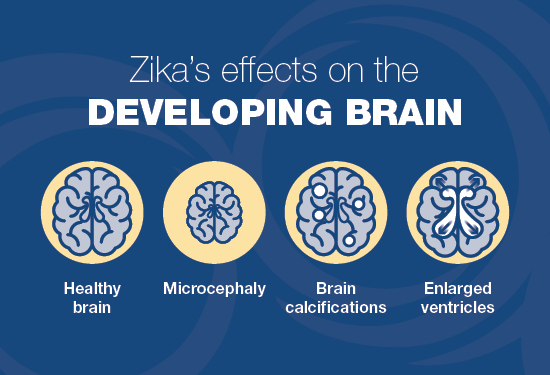
Infographic showing Zika's effects on the developing brain. Credit: NICHD/NIH
The emergence of Zika virus has led to a surge in cases of microcephaly and other severe birth defects. The virus spreads primarily through the bite of an infected Aedes aegypti mosquito, but it also can be transmitted through sexual contact with an infected person and from a woman to her fetus during pregnancy.
In February, NICHD and other NIH institutes announced research priorities to understand how Zika virus infection affects reproduction, pregnancy, and the developing fetus. NICHD used an expedited funding method to begin research as quickly as possible and leveraged existing collaborations in Zika-endemic areas to plan observational studies of pregnant women.
In May, NICHD-funded researchers reported that Zika virus infection crosses the placentas of pregnant mice and causes severe defects or death in their fetuses, providing clues on how the virus disrupts fetal development in people. In June, NICHD and others launched the international Zika in Infants and Pregnancy study to evaluate the health risks that Zika poses during pregnancy and after birth.
NICHD also organized and hosted a scientific workshop in September to identify the best approaches for treating and caring for children exposed to Zika virus in the womb. Experts from around the world, including those who care for Zika-affected infants and families, discussed treatment options, management guidelines, research needs, and lessons learned from other congenital infections.
Leading Research on Women's Health

Stock image of women.
Women experience unique health issues and conditions, from pregnancy and menopause to gynecological conditions, such as endometriosis and polycystic ovary syndrome.
Endometriosis is an often painful condition that occurs when tissue that lines the inside of the uterus grows in other areas of the body. In March, NICHD-supported researchers linked endometriosis to an increased risk for heart disease. The highest risk was seen in women who had undergone a hysterectomy and had their ovaries removed, which may be done to relieve endometriosis-related pain. As a result of these findings, women who have endometriosis are encouraged to receive periodic checkups for the early stages of heart disease and to consider adopting a heart-healthy lifestyle.
Polycystic ovary syndrome (PCOS) is a set of symptoms that result from a hormonal imbalance. Symptoms include not ovulating, irregular or missing menstrual periods, infertility, excess body or facial hair, weight gain, and cysts (fluid-filled pockets of tissue) on one or both ovaries. In June, researchers at NICHD reported that some women with PCOS might have an adrenal gland disorder that contributes to the hormonal imbalance. Earlier in the year, NICHD-funded researchers also found that, for overweight women with PCOS who are considering fertility treatments, losing weight before starting fertility treatments may improve pregnancy rates.
Studying Infertility and Pregnancy Loss

Stock image of couple and doctor.
Millions of people in the United States, about 7 percent of men and 11 percent of women, have experienced fertility problems. In March, NICHD-supported researchers identified a cellular switch that boosts the activity of sperm cells. The findings may lead to new options for male contraception, as well as treatments for infertility caused by problems with sperm mobility. Earlier in the year, NICHD researchers reported reassuring findings that infertility treatments do not contribute to developmental delays in children by 3 years of age. The study team will continue to evaluate the children until they are 8 years old to confirm the finding.
Miscarriage, or pregnancy loss, continues to be an issue in the United States, with an estimated rate of 15 to 20 percent among women who know they are pregnant. In January, NICHD researchers reported that couples that attempt to conceive within three months after a miscarriage have the same, if not greater, chance of achieving a live birth than those who wait longer. While couples may need time to heal emotionally, for those who are ready, there appears to be no physical reason for delaying attempts at conception.
In March, NICHD researchers found that a couple's caffeine consumption prior to pregnancy may be linked to miscarriage risk. Couples who drank more than two caffeinated beverages a day were more likely to miscarry, compared to those who drank less. In addition, the researchers found that women who took a daily multivitamin before conception and through early pregnancy were less likely to miscarry than women who did not. The findings provide useful information for couples who are planning a pregnancy and are trying to reduce their miscarriage risk.
Promoting Healthy Pregnancies
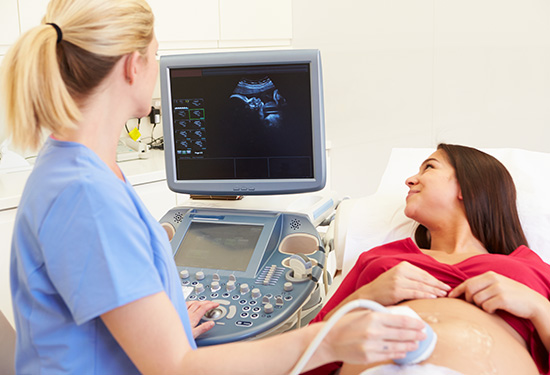
Stock image of an ultrasound exam.
A healthy pregnancy optimizes future health outcomes for both mom and baby. Unfortunately, more than 600 women die each year in the United States as a result of pregnancy or delivery complications, such as preeclampsia, maternal hemorrhage, and post-operative infections. Earlier this year, NICHD-funded researchers estimated that the maternal mortality rate in 48 U.S. states and Washington, DC, had increased by more than 26 percent, from approximately 19 deaths per 100,000 live births in 2000 to nearly 24 deaths per 100,000 live births in 2014.
The public health community is working to address this troubling trend. For instance, several NICHD-supported studies have explored ways to prevent post-operative infections. In February, researchers found that the skin antiseptic chlorhexidine-alcohol was more effective than iodine-alcohol in reducing infection rates after cesarean delivery. In September, another group of NICHD-supported researchers reported that treatment before an unplanned cesarean delivery with the antibiotic azithromycin in addition to standard antibiotics reduced the rate of infection after surgery by half.
Healthy behaviors before and during pregnancy also are important for promoting healthy outcomes. In January, NICHD researchers found that women who ate more potatoes before pregnancy had higher rates of gestational, or pregnancy-related diabetes, compared to women who ate fewer potatoes. While the study did not prove cause and effect, the researchers propose substituting other vegetables, legumes, or whole grains for potatoes, which can raise blood sugar levels. In March, NICHD researchers also reported that mice with prenatal exposure to marijuana's active ingredient lose a key subset of neurons called CCK-INTs. This loss was concentrated in an area of the brain called the hippocampus, which is involved in forming memory and regulating mood. The findings offer an explanation on how marijuana use during pregnancy may lead to cognitive problems in children.
Improving the Health of Infants

Stock image of newborn and mom in hospital.
Preterm birth, defined as birth before 37 weeks of pregnancy, is a leading cause of infant death and long-term disability. Steroids are a standard treatment for women likely to deliver before 34 weeks of pregnancy because these drugs can reduce respiratory and other complications. However, late preterm infants who are born between 34 and 36 weeks also have a risk of respiratory complications, but there is no standard treatment for them.
In February, NICHD researchers reported that prenatal steroid therapy reduces the risk of respiratory problems in late preterm infants. In October, NICHD-funded researchers added to these findings by showing that even partial steroid treatment can benefit extremely preterm infants who are born between 22 and 27 weeks of pregnancy. Reducing neonatal respiratory complications can lead to fewer hospital visits, earlier infant-mom bonding, and better long-term lung and general health.
Infant care also extends beyond pregnancy and delivery. For example, some infants may require surgery and general anesthesia after birth to repair an inguinal hernia, which occurs near the groin and causes pain. In June, NICHD-funded researchers reported reassuring findings that healthy children who had received anesthesia before age 36 months had no differences in IQ scores when compared to siblings who never received anesthesia.
Lastly, diagnosing the cause of fever in infants is often challenging for health care providers. Standard tests require growing bacteria from body fluids—blood, urine, or spinal fluid—and require invasive medical procedures, such as a spinal tap. Physicians also may need to admit the infant to a hospital for several days while awaiting test results. In August, NICHD-supported researchers showed that it is possible to diagnose a bacterial infection from a small sample of blood taken from infants with fevers. While more work is needed to optimize this approach, such a fast, less-invasive approach holds promise for early diagnosis and lower treatment costs.
Preventing HIV Transmission
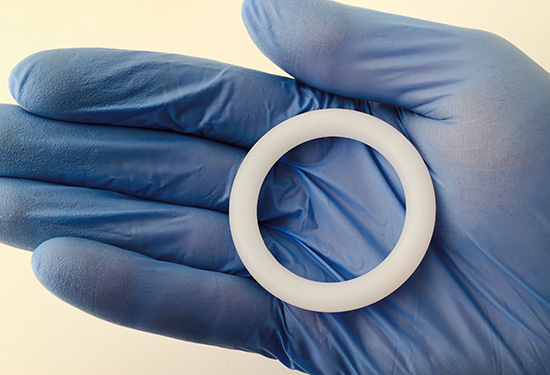
Image of vaginal ring. Credit: NIAID/NIH
Nearly 37 million people worldwide are living with HIV, including 2 million people who became infected in 2015. Improvements in HIV screening, prevention, and treatments promise to help reduce new cases and increase the quality of life for people with HIV.
In February, NICHD- and NIH-supported researchers reported that a vaginal ring that continuously releases an experimental anti-HIV drug protects against HIV transmission. The ring reduced the risk of HIV infection by 61 percent among women ages 25 years and older, the group that used the ring most consistently. Women under 21 years of age used the ring less consistently and had lower protection rates, leading researchers to recommend further research to better understand their unique prevention needs. Developing discreet HIV prevention methods for women is critical for their health and for preventing new infections.
In July, another group of NICHD-supported researchers found that anti-HIV drugs can eliminate mother-to-child transmission of HIV among breastfeeding mothers. The study team found that two types of therapy, one for mom and one for baby, were both effective. The findings can reassure HIV-infected mothers, who may not have access to alternative feeding methods or clean water for mixing formula, that breastfeeding is a safe option if they are taking anti-HIV drugs.
In September, NICHD and NIH funded a research network devoted to the health and well-being of U.S. teenagers and young adults with HIV or at risk for HIV infection. While many new HIV infections occur in young people, they often are not diagnosed in a timely manner nor do they receive medical care. Their health can suffer, and they risk passing the virus to others. The Adolescent Medicine Trials Network for HIV/AIDS Interventions aims to get HIV-infected and at-risk youth into care and offer them participation in research trials that may improve their health and the health of others.
Enriching Early Learning

Stock image of mom and daughter.
What children learn in their first few years of life—and how they learn it—can have long-lasting effects on their health and on their later success in school and in work.
In January, NICHD-supported researchers showed that a simple feedback program, called the Video Interaction Project, helped low-income mothers interact more effectively with their infants and toddlers. Mothers were recorded while they read to or played with their children during routine checkups at the pediatrician's office. Then, a child development specialist reviewed the video with the mother, highlighting and teaching positive interactions. The children of mothers who participated in the program reported better attention and play skills as toddlers, as well as less hyperactive and aggressive behavior. The program also reduced children's hyperactive behaviors by more than half among families in the study who had experienced violence, homelessness, significant financial hardship, or mental illness.
Later in the year, a different group of NICHD-funded researchers reported that infants with exposure to more than one language are better able to see a situation from another point of view. The findings suggest that infants who are not yet able to speak can still understand nonverbal cues from others and that infants from multilingual backgrounds may be more proficient at recognizing these signs.
In April, NICHD-supported researchers tested a five-minute computer game designed to exercise intuitive number skills with kindergartners. They found that children who played the game with easy questions that progress to harder questions did best on a subsequent math exam. Children who played the game with a mix of easy and hard questions, or with hard questions first, did not perform as well. The researchers are exploring if this exercise can produce long-lasting results or improve other types of math abilities.
Understanding and Treating Autism

Stock image of boy.
Autism spectrum disorder is a complex developmental condition that affects how a person behaves, interacts with others, communicates, and learns. Different people experience different symptoms, and the exact causes of autism are unknown.
In May, NICHD-supported researchers reported a better way to use magnetic resonance imaging (MRI) to study autism in children. MRI studies are used to examine how the brain is affected by autism over time, but these studies often are limited to higher functioning kids who can undergo an MRI scan without sedation. The researchers developed a protocol for school-age children who have autism and intellectual impairment that uses mock visits and positive behavior reinforcement to prepare them for an MRI scan. Studies like these help ensure that long-term studies of brain development in autism can include children at all levels of functioning, from infancy to childhood.
A common symptom of autism is being oversensitive to sensory signals. In May, NICHD-funded researchers who use MRI to study autism identified brain activity patterns, notably during rest, that are linked to this type of hypersensitivity. These findings can help clinicians better understand how the brain overreacts to mild stimuli, possibly leading to therapies for overstimulation among people with autism.
In October, NICHD-supported researchers who study neurofibromatosis type 1, a neurological disorder, linked a gene called NF1 to autism-like symptoms. While these findings are specific to neurofibromatosis type 1, they may help autism researchers identify related genes that contribute to autism in people who do not have mutations in NF1.
Advancing Knowledge of Pediatric Diseases
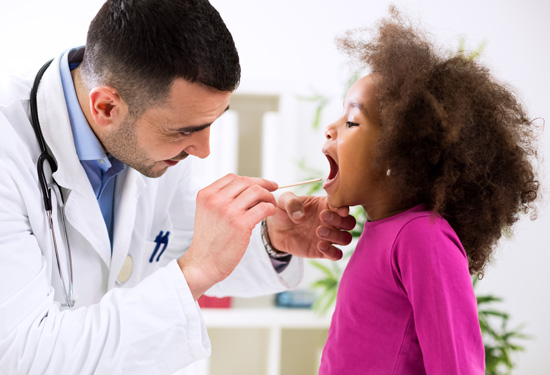
Stock image of doctor examining child.
Newborn screening programs help identify infants who are at risk for certain diseases, allowing for early intervention and treatments. In February, NICHD-funded researchers reported a faster and cheaper screening test for cystic fibrosis, a disorder that damages the lungs and digestive system. In May, NICHD researchers, in collaboration with Washington University in St. Louis, described a newborn screening test for Niemann-Pick type C, a rare but fatal neurological disease. Currently, the disease is diagnosed only after children show symptoms.
In May, NICHD scientists reported that a rare cancer, called pheochromocytoma and paraganglioma, may masquerade as attention deficit hyperactivity disorder (ADHD) in children. If a child with the rare cancer is wrongly diagnosed with ADHD, they may receive treatment that could worsen their health. The study team cautioned health care providers, suggesting that high blood pressure accompanying a diagnosis of ADHD could be a warning sign that the child may have something else.
NICHD also supports research that evaluates the safety, dosage, and efficacy of medications in children. In March, NICHD-supported researchers showed that the liquid and capsule versions of a drug used to treat sickle cell anemia have the same blood concentrations, meaning the two formulas are interchangeable. Many children are unable to swallow capsules or pills, and they may not be available in a dose suitable for smaller sized children. Providing easy-to-swallow liquid formulas enable children to take medicine, especially for long-term conditions.
Enhancing Rehabilitation Research
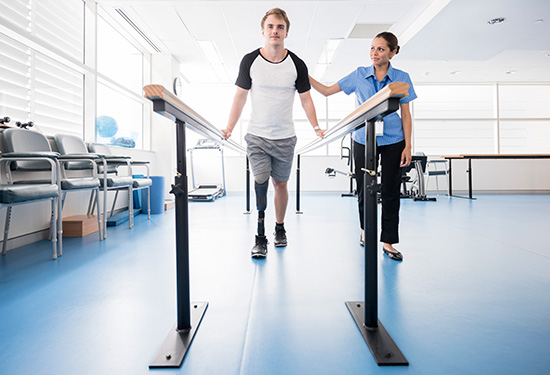
Stock image of man with prosthetic leg undergoing physical therapy.
Approximately one in five adults in the United States has a disability. Earlier this year, NICHD led the effort to develop and release the NIH Research Plan on Rehabilitation, which provides a five-year framework for advancing the rehabilitation research field and helping people with disabilities reach their full potential.
In March, the Food and Drug Administration approved the use of a "wearable robot" that allows people who are paralyzed below the waist to stand up and walk. The powered, lower-limb exoskeleton initially was created with NICHD funding and took about 10 years to develop. In July, NICHD-funded researchers developed a device that stabilizes the gait of people who use above-the-knee leg prosthetics. In the fall, NICHD-supported researchers created an exoskeleton for infants with arthrogryposis, a condition that causes joint problems. The device may help improve an infant's arm mobility over time.
In June, NICHD-funded researchers reported findings important for adolescent idiopathic scoliosis, a childhood condition in which the spine curves for unknown reasons. Using a zebrafish model, the researchers discovered that abnormal flow of cerebral spinal fluid, which bathes the brain and spinal cord, causes the spine to curve. The results suggest that it may be useful to examine the flow of spinal fluid in children with scoliosis.
NICHD-supported researchers also made improvements in diagnosing and treating brain injuries. In September, researchers described a method to diagnose chronic traumatic encephalopathy (CTE), a neurodegenerative disease that can cause depression, anxiety, and dementia. Currently, the disease only can be confirmed after an autopsy. The experimental imaging test may be able to diagnose CTE earlier, potentially allowing for treatment. Researchers also are looking for ways to help improve recovery outcomes for stroke survivors. One recent study focused on social networks and found that wearable cameras could help health care providers encourage lifestyle changes for those recovering from stroke.
References
Understanding Zika Virus
- NIH seeks research applications to study Zika in pregnancy, developing fetus. NICHD Media Advisory (2016)
- Miner JJ et al. Zika virus infection during pregnancy in mice causes placental damage and fetal demise. Cell DOI: 10.1016/j.cell.2016.05.008 (2016)
- NIH launches large study of pregnant women in areas affected by Zika virus. NIH News Release (2016)
- NIH to host scientific workshop on Zika virus and child development. NICHD Media Advisory (2016)
Leading Research on Women’s Health
- Mu F et al. Endometriosis and risk of coronary heart disease. Circulation Cardiovascular Quality Outcomes DOI: 10.1161/CIRCOUTCOMES.115.002224 (2016)
- Gourgari E et al. Bilateral adrenal hyperplasia as a mechanism for hyperandrogenism in women with polycystic ovary syndrome. J. Clin. Endocrinol. Metab. DOI: 10.1210/jc.2015-4019 (2016)
- Legro RF et al. Benefit of delayed fertility therapy with preconception weight loss over immediate therapy in obese women with PCOS. J. Clin. Endocrinol. Metab. DOI: 10.1210/jc.2016-1659 (2016)
Understanding Infertility and Pregnancy Loss
- Miller MR et al. Unconventional endocannabinoid signaling governs sperm activation via the sex hormone progesterone. Science DOI: 10.1126/science.aad6887 (2016)
- Yeung EH et al. Examining infertility treatment and early childhood development in the Upstate KIDS Study. JAMA Pediatrics DOI: 10.1001/jamapediatrics.2015.4164 (2016)
- Schliep KC et al. Trying to conceive after an early pregnancy loss: an assessment on how long couples should wait. Obstetrics and Gynecology DOI: 10.1097/AOG.0000000000001159 (2016)
- Buck Louis GM et al. Lifestyle and pregnancy loss in a contemporary cohort of women recruited before conception: The LIFE Study. Fertility and Sterility DOI: 10.1016/j.fertnstert.2016.03.009 (2016)
Promoting Healthy Pregnancies
- MacDorman MF et al. Recent increases in the U.S. maternal mortality rate: disentangling trends from measurement issues. Obstetrics and Gynecology DOI: 10.1097/AOG.0000000000001556 (2016)
- Tuuli MG et al. A randomized trial comparing skin antiseptic agents at cesarean delivery. NEJM DOI: 10.1056/NEJMoa1511048 (2016)
- Tita AT et al. Adjunctive azithromycin prophylaxis for cesarean delivery. NEJM DOI: 10.1056/NEJMoa1602044(2016)
- Bao W et al. Pre-pregnancy potato consumption and risk of gestational diabetes mellitus: prospective cohort study. BMJ DOI: 10.1136/bmj.h6898 (2016)
- Vargish GA et al. Persistent inhibitory circuit defects and disrupted social behaviour following in utero exogenous cannabinoid exposure. Molecular Psychiatry DOI: 10.1038/mp.2016.17 (2016)
Improving the Health of Infants
- Gyamfi-Bannerman C et al. Antenatal betamethasone for women at risk for late preterm delivery. NEJM DOI: 10.1056/NEJMoa1516783 (2016)
- Chawla S et al. Association of neurodevelopmental outcomes and neonatal morbidities of extremely premature infants with differential exposure to antenatal steroids. JAMA Pediatrics DOI: 10.1001/jamapediatrics.2016.1936 (2016)
- Sun LS et al. Association between a single general anesthesia exposure before age 36 months and neurocognitive outcomes in later childhood. JAMA DOI: 10.1001/jama.2016.6967 (2016)
- Mahajan P et al. Association of RNA Biosignatures With Bacterial Infections in Febrile Infants Aged 60 Days or Younger. JAMA DOI: 10.1001/jama.2016.9207 (2016)
Preventing HIV Transmission
- Baeten JM et al. Use of a vaginal ring containing dapivirine for HIV-1 prevention in women. NEJM DOI: 10.1056/NEJMoa1506110 (2016)
- HIV therapy for breastfeeding mothers can virtually eliminate transmission to babies. NIH News Release (2016)
- NIH funds research network focused on HIV-infected youth. NIH News Release (2016)
Improving Early Learning
- Weisleder A et al. Promotion of positive parenting and prevention of socioemotional disparities. Pediatrics DOI: 10.1542/peds.2015-3239 (2016)
- Liberman Z et al. Exposure to multiple languages enhances communication skills in infancy. Developmental Science DOI: 10.1111/desc.12420 (2016)
- Wang JJ et al. Changing the precision of preschoolers’ approximate number system representations changes their symbolic math performance. J Exp Child Psychol. DOI: 10.1016/j.jecp.2016.03.002 (2016)
Understanding and Treating Autism
- Nordahl CW et al. Methods for acquiring MRI data in children with autism spectrum disorder and intellectual impairment without the use of sedation. J. Neorodev. Disord. DOI: 10.1186/s11689-016-9154-9 (2016)
- Green SA et al. Salience network connectivity in autism is related to brain and behavioral markers of sensory overresponsivity. J. Am. Acad. Child. Adolesc. Psychiatry. DOI: 10.1016/j.jaac.2016.04.013 (2016)
- Morris SM et al. Disease burden and symptom structure of autism in neurofibromatosis type 1: a study of the international NF1-ASD consortium team (INFACT). JAMA Psychiatry DOI: 10.1001/jamapsychiatry.2016.2600 (2016)
Advancing Knowledge of Pediatric Diseases
- Lefterova MI et al. Next-generation molecular testing of newborn dried blood spots for cystic fibrosis. J. Mol. Diagnostics DOI: 10.1016/j.jmoldx.2015.11.005 (2016)
- Jiang X et al. Development of a bile acid-based newborn screen for Niemann-Pick disease type C. Science Translational Medicine DOI: 10.1126/scitranslmed.aaf2326 (2016)
- Batsis M et al. Attention deficit hyperactivity disorder in pediatric patients with pheochromocytoma and paraganglioma. Hormone and Metabolic Research DOI: 10.1055/s-0042-106725 (2016)
- Estepp JH et al. Pharmacokinetics and bioequivalence of a liquid formulation of hydroxyurea in children with sickle cell anemia. J. Clinical Pharmacology DOI: 10.1002/jcph.598 (2016)
Advancing Rehabilitation Research
- NIH research plan on rehabilitation: moving the field forward (PDF - 443 KB). NIH Publication (2016).
- FDA approves Vanderbilt-designed Indego exoskeleton for clinical and personal use
 . Vanderbilt University News Release (2016).
. Vanderbilt University News Release (2016). - Plauche A et al. A haptic feedback system for phase-based sensory restoration in above-knee prosthetic leg users. IEEE Trans Haptics DOI: 10.1109/TOH.2016.2580507 (2016)
- Babik I et al. Feasibility and effectiveness of a novel exoskeleton for an infant with arm movement impairments. Pediatric Physical Therapy DOI: 10.1097/PEP.0000000000000271 (2016)
- Grimes DT et al. Zebrafish models of idiopathic scoliosis link cerebrospinal fluid flow defects to spine curvature. Science DOI: 10.1126/science.aaf6419 (2016)
- Dickstein DL et al. Cerebral [18 F]T807/AV1451 retention pattern in clinically probable CTE resembles pathognomonic distribution of CTE tauopathy. Translational Psychiatry DOI: 10.1038/tp.2016.175 (2016)
- Dhand A et al. Accuracy of wearable cameras to track social interactions in stroke survivors. Journal of Stroke and Cerebrovascular Diseases DOI: 10.1016/j.jstrokecerebrovasdis.2016.08.00(2016)

 BACK TO TOP
BACK TO TOP